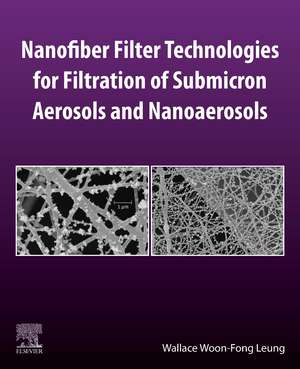Nanofiber Filter Technologies for Filtration of Submicron Aerosols and Nanoaerosols
Autor Wallace Woon-Fong Leungen Limba Engleză Paperback – 2 noi 2021
- Describes technologies with insight and use basic engineering principles to build-up technologies
- Includes extensive clear and understandable figures and tables to enhance key concepts
- Uses examples throughout to explain engineering principles and interdisciplinary concepts
- The only book in the market focusing on nanofiber filter technologies for filtering submicron aerosols and nanoaerosols
Preț: 965.32 lei
Preț vechi: 1260.45 lei
-23% Nou
Puncte Express: 1448
Preț estimativ în valută:
184.74€ • 200.60$ • 155.18£
184.74€ • 200.60$ • 155.18£
Carte tipărită la comandă
Livrare economică 15-29 aprilie
Preluare comenzi: 021 569.72.76
Specificații
ISBN-13: 9780128244685
ISBN-10: 0128244682
Pagini: 570
Dimensiuni: 191 x 235 mm
Greutate: 0.97 kg
Editura: ELSEVIER SCIENCE
ISBN-10: 0128244682
Pagini: 570
Dimensiuni: 191 x 235 mm
Greutate: 0.97 kg
Editura: ELSEVIER SCIENCE
Public țintă
University 3rd and 4th year studentGraduate student in university and research institutions
Research fellow and scientists
Engineers in filter media and engineering filtration products
HVAC engineers
Cuprins
1. Introduction to submicron aerosols and nanoaerosols
2. Fundamentals of gas filtration of submicron aerosols and nanoaerosols
3. Nanofiber production
4. Filter testing, filter test standards, and filter ratings
5. Multilayering for depth filtration
6. Transition from depth-to-surface filtration
7. Cake filtration with composite filter
8. Electret filters for depth and cake filtration
9. Numerical modelling of aerosol filtration using nanofiber filter
10. Cleaning of nanofiber filter
11. Nanofiber filter reuse
12. Filtering ambient aerosols
13. Applications of nanofiber filter
14. Outlook
2. Fundamentals of gas filtration of submicron aerosols and nanoaerosols
3. Nanofiber production
4. Filter testing, filter test standards, and filter ratings
5. Multilayering for depth filtration
6. Transition from depth-to-surface filtration
7. Cake filtration with composite filter
8. Electret filters for depth and cake filtration
9. Numerical modelling of aerosol filtration using nanofiber filter
10. Cleaning of nanofiber filter
11. Nanofiber filter reuse
12. Filtering ambient aerosols
13. Applications of nanofiber filter
14. Outlook
Recenzii
"It is particularly noteworthy that the book is written very clearly, understandably and in simple language, has a good structural content and can therefore be used not only for scientists, engineers, industrial manufacturers and health professionals, but also well for student teaching at universities. It should be emphasized that the book contains many calculation examples and lists of questions and the associated answers for the individual chapters, which then makes it easy to understand the content in university lessons.
In conclusion, it can be said that this book is particularly relevant at the time of the COVID-19 pandemic and can also make a contribution to defeat this disease." --Wilhelm Hoeflinger
"I am convinced that Wallace Leung's book will find many readers among experienced researchers, as it organizes knowledge on filtration in nonwoven nanofiber filters at various levels of research needs, and among those researchers who are at the stage of defining their scientific interests. The book can also serve as part of the contents for undergraduate and graduate courses in the aerosol, dispersed system, filtration, and separation in the university as well as a good reference for practicing engineers working in the arena of filtration and air quality." --Leon Gradon
In conclusion, it can be said that this book is particularly relevant at the time of the COVID-19 pandemic and can also make a contribution to defeat this disease." --Wilhelm Hoeflinger
"I am convinced that Wallace Leung's book will find many readers among experienced researchers, as it organizes knowledge on filtration in nonwoven nanofiber filters at various levels of research needs, and among those researchers who are at the stage of defining their scientific interests. The book can also serve as part of the contents for undergraduate and graduate courses in the aerosol, dispersed system, filtration, and separation in the university as well as a good reference for practicing engineers working in the arena of filtration and air quality." --Leon Gradon
